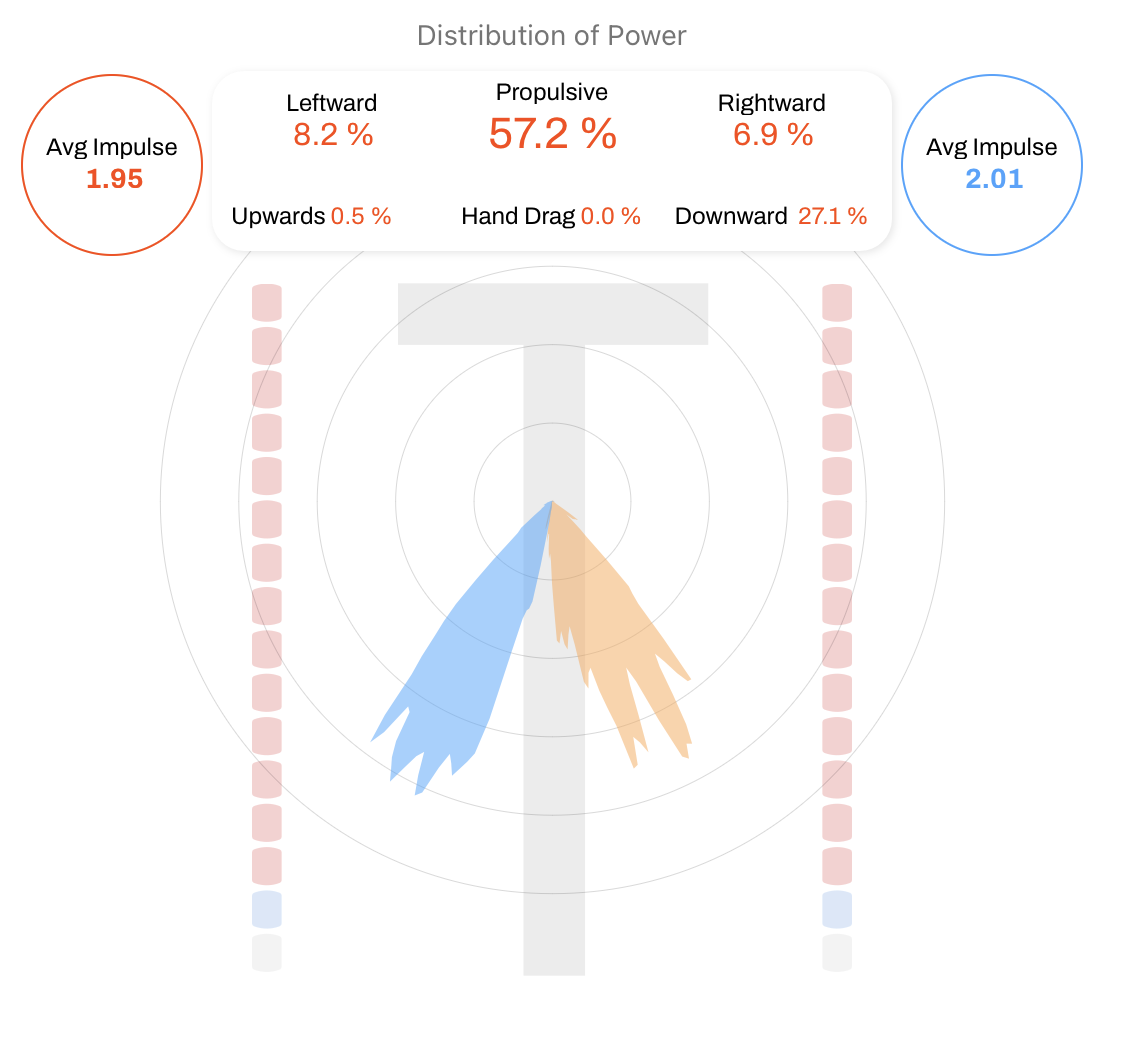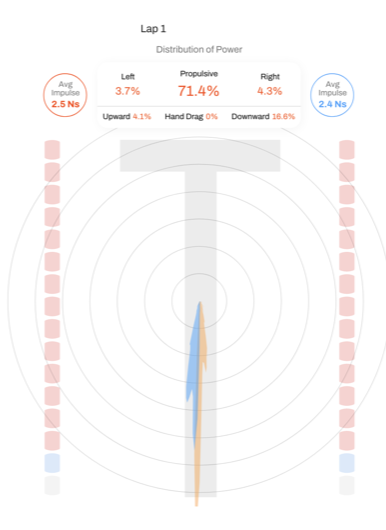Absolutely, it is really impressive. I definitely think freestyle is upper body dominated. Though Leon Marchand’s 500y freestyle might be kick-dominated : )
This is completely wrong. The directional force is absolutely relative to direction traveled, i.e. backward to the wall behind and away from wall in front.
[quote=“waterpolo, post:81, topic:1283457, full:true”]
Absolutely, it is really impressive. I definitely think freestyle is upper body dominated. Though Leon Marchand’s 500y freestyle might be kick-dominated : ) [/quote]
TBH, I don’t believe I’ve ever watched Marchand’s 4:02 performance. I should be able to find some time to watch it tomorrow, and then I’ll let you know what I think.
OK maybe you just don’t understand how vector forces work. There are clearly a ton of lateral direction forces being applied in a rotating motion in free and back stroke (and even in the pull in breast). The side to side forces cancel each other out (if not the swimmer ends up moving to one side which generally they don’t…or they self correct by snaking around in the water)…but yes all net forces when added result in forward motion. If you don’t understand how vector forces work, you’ll just simplify this and say its is wrong. You are correct that NET forces are backward but lots of individual forces all over the place that are directionally NOT BACKWARDS. I posted the picture of Ledecky to illustrate the point.
I am not sure if you did any fluid dynamics studies (ships, boats, airplanes etc), so if you haven’t you may not even understand what is going on with the various forces the swimmer applies.
Relative to the spine, sure it may feel like the pulling is straight back but due to spine rotation that’s not the instantaneous force direction on the water.
No. You’re totally off base here. I can put my 12 yo swimmers in a totally flat, catch-up drill, and their forces are absolutely backwards with no rotation and they are probably faster than you at the same time.
Stay in your lane. The forces are not lateral in any universe.
Edit: and btw, because I don’t have the patience to wait for your ill-informed response, I’ll take my ASCA education and my kids’ national AAA, AAAA, and T16 times and continue to believe what I’ve observed.
This has nothing to do with my times or one upmanship of who is faster or not. We’re just talking force that play out in swimming. If you can’t understand that there are all kind of lateral forces that net out of zero laterally and net out to backward aggregate force that overcomes drag for speed, then that’s your choice to believe all instantaneous forces are exclusively backwards. Even in your flat catch up drill that you speak of, the forces are not exclusively backward. Its impossible because the shoulder itself is socket joint. Even if you want to move the hand directly backward there are rotational forces in the shoulder and the upper and lower arm. Its why you can generate forward motion just by skulling side to side and a bird can generate forward motion moving wings up and down. In both case the motion is orthogonal to the direction of motion. How do you think this all happens in a fluid?
How much does flexibility play into the discussion when comparing young swimmers to older AG swimmers verses strength? Watching both, the well muscled adults seem to have trouble getting their hands out of the water on the recovery and getting length out of their reach so they seem to use churn to try to go faster.
benchpress doesnt correlate to any of the swim strokes. maybe the pull up does for the fly. For free style it would at best be an exercise that starts as a 1 arm lat pull down, but finishes as a tri extension. YOu would also have to account power to weight ratio. kind of like this (but the palm should be facing down) Cable One Arm Pulldown - Guide, Benefits, and Form
Yeah i was mean, snapping after you spoke to me like a child about vector forces.
You’re overcomplicating stuff. After years and years of learning, observing, and teaching, swimmers of all abilities, some very fast, the better ones always anchor and apply force directly backwards. We don’t want to return to the 80s and trying to explain swimming with hydrodynamics and physics and s curves, etc.
We’re more like a kayak and we (want to) apply force directly backwards.
You got caught up in text and jumped to conclusions. We said the same thing but with one subtulty that you are missing in what I wrote. The hand and and forearm may try to apply force backwards relative to the spine, but relative to the direction of travel, its not doing that continuously. There is a duration in the pull phase where it is directly backwards relative to direction of travel, but that’s not the case during the entire stroke cycle because of the rotation.
I think we can have a proper conversation about forces and timing of forces without getting into one upmanship of who can swim faster or not or which 12 year olds are superstars. The ability to swim faster or not has nothing to do with how fluid dynamics physics work. Neither Fish nor kids may understand the math but they can move fast without understanding the math around it, but the discussion was around vector forces before you jumped in with a universal declaration (and I already showed an image of Ledecky clearly moving forward with zero motion that is backwards relative to the pool at that phase of the stroke. It is all to the sides relative to direction of travel.
There is a reason why the pitch of a properller is certain degrees for max efficiency at a given power output and fluid speed. That’s what good swimmers get to with the heart of the pull phase, but the rest is important in long axis strokes.
Just to be clear, I am not advocating anything about any style of swim stroke. There are a ton of people who know way more. I am jump summarizing what is going on in the fluid dynamics domain. You may not even understand that (maybe you do), but nothing I have said is decoupled from what vector forces we see being played out in real life.
Also I don’t attack anyone in person. As I post often enough on this forum, many will jump on what I have written, which is fine and a discussion can ensue, but those discussions can be done focused on the topic without bringing the people into it. As you appear to be new to this forum, I would ask you to add to the culture this way and we’re going to have positive interactions here
A lot for sure. It doesn’t get brought up a ton, but it does seem all the fastest swimmers have some crazy shoulder/arm flexibility and can get some really high elbow recoveries that are totally impossible for folks like me. Although I’m skeptical that the forward reach movement is a flexibility issue - that’s more of a technical issue, learning to hold that front arm steady without pulling it back too early, and yeah, that seems to be one of the biggest errors in adult swimmers (me included, still constantly work on it.)
I think the original point was that a direct backwards force is the most efficient possible use of that force. You’re correct that it’s not the reality of how people swim, and a net forward force is usually better than no forward force.
What I was getting at is that the aforementioned fast kids have very little wasted effort in the movement. We all know the catch is supposed to be minimal force and the pull is supposed to be where the power goes in. Plenty of AOS rip thru the catch in a way that uses energy but didn’t help them move forward very much. Using more muscle ineffectively can lose to less muscle more effectively.
The swim is so complicated and I probably tried to reduce the analogy too much at first. Even just the role of momentum is huge. Throwing your arm forward and stopping it in the reach is a nonzero event.
That’s not true. There is a correlation between 1RM bench press and swimming performance.
Swimmers should be driving the water directly behind them.
The data below is from a pro triathlete and a swimmer who qualified for the World Championships…
Pro Triathlete
World Championships Swimmer
Fascinating graphs. Is it saying the the left hand pushes to the right and the right hand pushes to the left? The other huge difference is the downwards/upwards force. Do you think that’s a reflection of the catch being better in the swimmer? Or something more nuanced in the stroke as a whole?
Really cool stuff
Thank you Tim ![]()
Very glad you chimed in on this thread. I was waiting for you to post the images.
It is. My interpretation is that it is an athlete who is unstable in the water and trying to get more stability.
The downward force is probably more of a reflection of body position in the water. The swimmer is higher up on the water, more stable and can set the catch from a better position.
The difference in the upward force .5 vs. 4.1 is that even the best swimmers have room to improve. You want that as close to zero as possible just like hand drag. You can see in the graph that the swimmer has less of a “tail” on the right than the left. My guess if you saw the video would be the swimmer is pulling up their right hand sooner or the pull pattern is a little deeper in the front compared to the left.
As a breaststroker in my actual competition days (during the time of the dinosaur) I am well aware that the pull takes extraordinary strength. So it did amuse me that someone would say breaststroke is leg dominant.
Mind you, I have the knees to prove it’s damage to them. No triathlete should ever practice it, especially as an adult learner.
Data source?
Go look it up. There’s a few studies out there on it. But I can tell you from 40 years experience as an athlete and as a coach what you said isn’t true.

